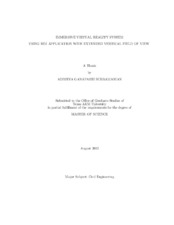| dc.description.abstract | Building Information Modeling (BIM) model contains information about structural, architectural, MEP (Mechanical Electrical and Plumbing) and other numerous components of a building. Among these components, MEP constitutes about 50% of the project cost, and its design is relatively more complex because of the limited headroom available to locate these components. The coordination of these systems involves locating and routing several subcomponents in a manner that satisfies different types of constraints. The earlier version of BIM Computer Aided Virtual Environment (CAVE) did not have provisions to show the overhead components of a BIM model. Conventionally, models had to be tilted to visualize the overhead components. The process of tilting the models to look up is considered counterintuitive. Some of the popular CAVEs developed by leading Universities have a screen on top to show the overhead components but they have a major shortcoming with them. The BIM models had to be converted to a specific format before they can be visualized in the CAVE environments. This study is an attempt to address the shortcomings of the previous version of the BIM CAVE by suggesting a prototype setup with a 55" LCD screen on top of the existing three vertically placed LCD screens. The addition of one more screen on top increases the vertical field of view, that is, the extent to which the user can see vertically in a BIM model. The new BIM CAVE setup is run by a custom built application that makes use of the .Net API (Application Programming Interface) of the commercially available BIM application, Autodesk Navisworks 2012, to control the camera views for achieving an almost seamless semi-immersive virtual environment.
The main objective of this research is to validate the effectiveness of the new setup suggested by using a qualitative research methodology called phenomenological study. Semi-structured informal interviews were conducted with the subject matter experts (SMEs) who are experienced in the field of BIM to know about the differences in the user experience after adding a screen on top of the earlier BIM CAVE setup. The main idea behind this qualitative research technique is to develop an understanding of how the SMEs perceived the idea of looking up to see the overhead components of the BIM model. This thesis explains the steps followed to develop the modified BIM CAVE setup in detail and findings of the qualitative study to know about the effectiveness of the suggested new setup. | en |


